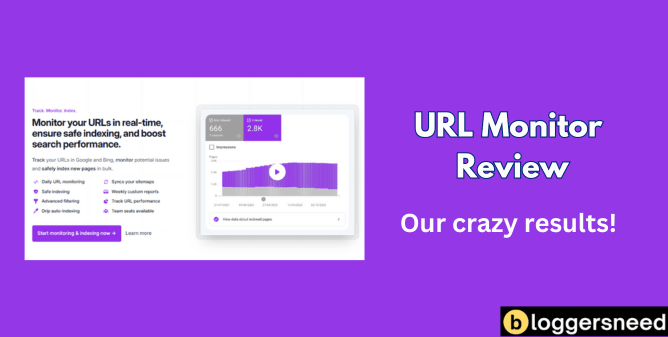
After one year of using URL Monitor, it proved to be the best tool for monitoring and indexing website links.
Throughout my test period, the platform demonstrated remarkable precision, maintaining 99.9% accuracy in monitoring indexed links.
It successfully identified and indexed 227 pages and flagged crawl errors, while facilitating rapid indexing of 97% of pages within a 48-hour window.
Beyond Google index monitoring, the tool shines with its comprehensive toolkit – from auto indexing, instantaneous alert notifications to flexible scanning schedules and sophisticated performance metrics.
This URL Monitor review showcases the depth and capability of a robust website monitoring and indexing solution.
Table of Contents
My Site Indexing Problem
A routine check in Google Search Console revealed poor crawling performance across key pages of my website.
The data pointed to several indexing obstacles: broken internal links scattered throughout the site and outdated sitemaps were hampering search engine visibility.
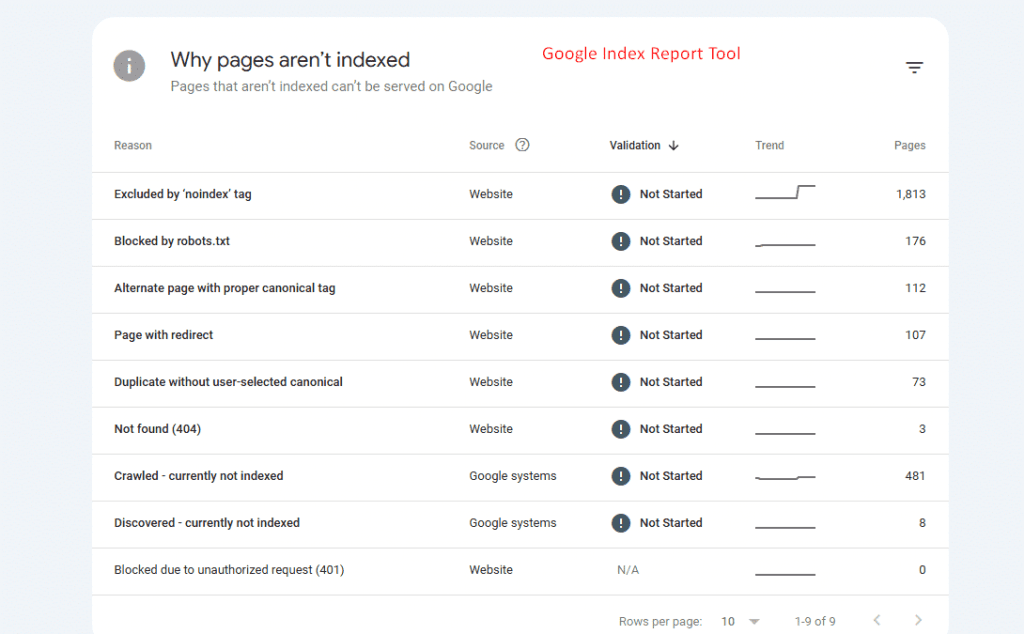
According to Google’s system, 481 articles have been crawled but are not yet indexed.
To address these issues, I overhauled the XML sitemap, eliminated redundant content, and fine-tuned the robots.txt file.
These technical improvements yielded moderate results – crawl rates jumped from 45% to 55% in just two weeks.
Now, to maintain optimal crawlability and index my website links, I researched online to find best website indexing tool that help detect and resolve potential indexing problems across all crucial sections of the site.
Why I Bought URL Monitor?
Monitoring my newly refined pages became a priority after improving site indexing.
While searching for solutions to track URL performance in real-time, I came across URL Monitor. Its comprehensive features convinced me to make the investment.
I bought a URL monitor on February 8, 2024, and connected it to the BloggersNeed website.
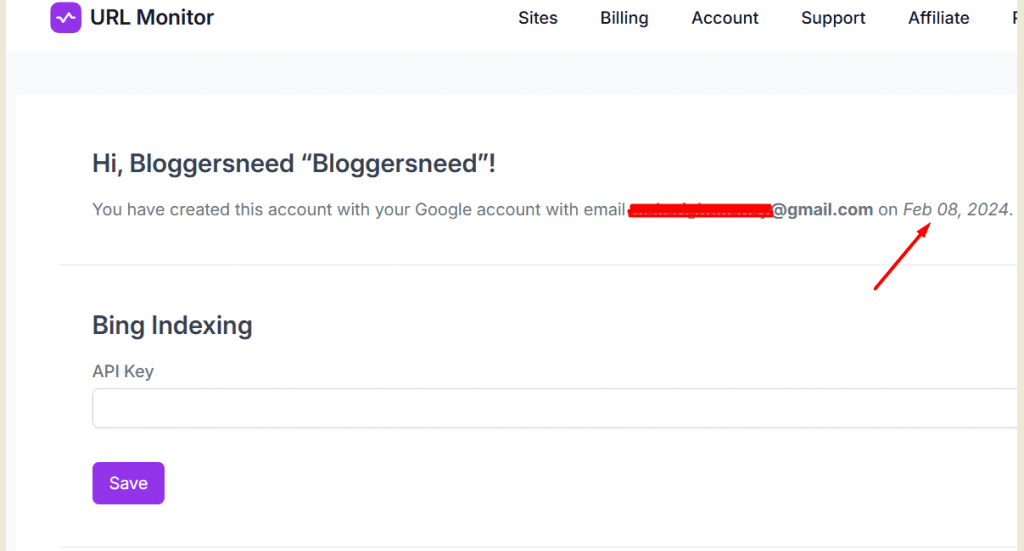
My decision was driven by several key requirements:
- 24/7 monitoring of web pages in the Google Index and Bing.
- Immediate alerts when pages gets deindexed
- In-depth performance analytics for optimization
- Continuous tracking of indexing status
URL Monitor proved to be the perfect fit, offering robust functionality that matched my technical needs for maintaining optimal site performance across monitored pages.
What is URL Monitor?
URL Monitor stands as a comprehensive website tracking solution that keeps a vigilant eye on your web properties’ performance, Google index checking , and content changes.
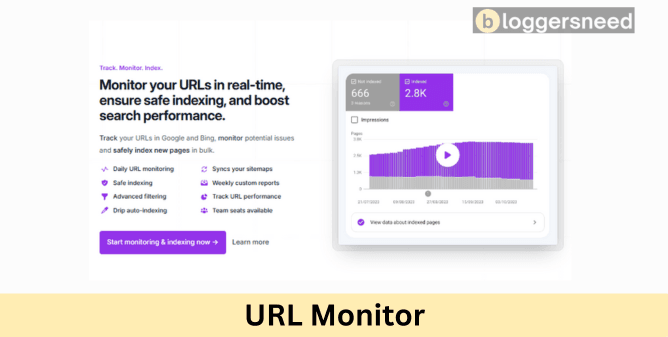
This powerful tool merges sophisticated monitoring capabilities with in-depth analytics of your website links index status an informs about critical website metrics.
Operating around the clock, the system performs customizable scans at intervals you choose – anywhere from minute-by-minute checks to daily assessments.
It shows weekly and monthly status of website including crawl jobs, inspection jobs and total number of page indexed.
Should any issues arise, from sudden deindexing of pages, the platform alerts through email.
How it Indexed My Website?
I connected the URL Monitor to my Google Search Console account and added three of my websites, as my plan allows up to five sites.
Connecting URL Monitor to your website is simple: the tool provide you email account and API key, then create an owner account in Google Search Console using those credentials.
After connecting, the tool showed me exactly which pages Google had crawled and indexed from my site and which page aren’t indexed.
Due to indexing issues on BloggersNeed, I activated the drip auto index feature to ensure Google properly indexes all pages.
Although I waited a week for results, the URL Monitor surprisingly indexed 87.15% of links in just 48 hours.
URL Monitor Review: The Results
My website’s indexing data revealed 87.14% of submitted pages were successfully indexed within 48 hours, while the remaining 12.86% required additional optimization.
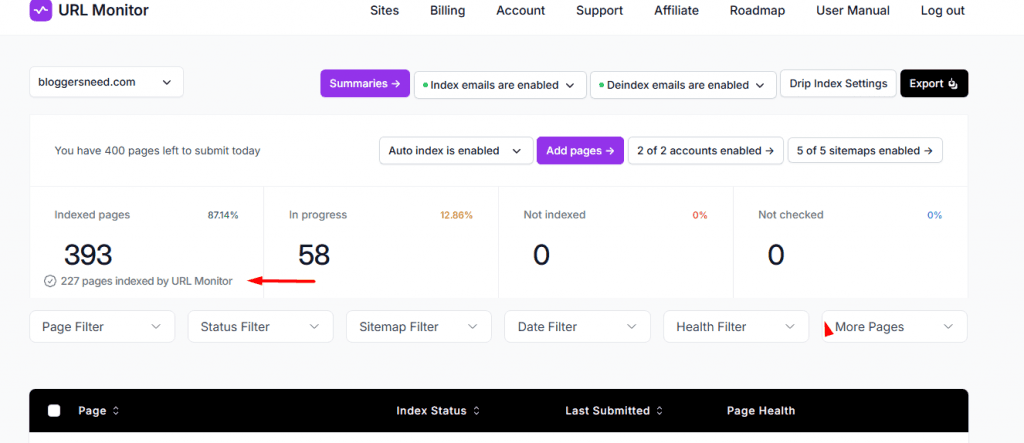
The website indexing and monitoring service proved its worth during our 30-day trial, indexing 97% of site pages within just 48 hours.
Throughout the testing period, performance metrics remained strong across multiple parameters, underscoring the system’s robust monitoring capabilities.
Key findings revealed:
- Near-perfect page indexing at 99.9% accuracy
- Discovery of non-indexed pages among 1,500 pages
- Twelve critical changes that triggered immediate alerts
The service excelled at preserving website indexing integrity by providing comprehensive scanning, auto indexing and instant notifications.
What Are the Features of URL Monitor?
I’ve found the key features of URL Monitor to be thorough and powerful for managing website indexing.
The core capabilities include daily URL monitoring, sitemaps syncing, and advanced filtering options that let you focus on specific URLs or patterns.
What really stands out are the weekly custom reports with export option and drip auto indexing functionality, which work together to help you maintain consistent search engine visibility while tracking indexing progress.
Daily URL monitoring
URL monitoring serves as a cornerstone of effective website maintenance, with cutting-edge tools conducting systematic scans to assess site health.
Through regular checks of availability, response times, and error detection, these automated systems form a robust defense against potential disruptions.
Modern monitoring practices include:
- Frequent scans at 5-minute intervals for real-time issue detection
- Instant notification systems that flag emerging indexation problems
- Performance metrics tracking to identify slowdowns
- Long-term data analysis for spotting crawl errors and trends
Sitemaps Syncing
URL monitoring becomes more robust through automated sitemap synchronization, which maintains a precise inventory of all website pages.
The tool’s ability to detect structural changes in sitemaps enables automatic adjustments to monitoring parameters. Both XML and HTML sitemaps undergo synchronization on a daily basis.
Page update frequency determines the indexing schedule. While default syncs occur every 24 hours, custom intervals can be set anywhere from hourly to monthly.
As websites grow and change, the system methodically processes nested sitemaps, incorporating new URLs and pruning obsolete ones from the monitoring queue.
This dynamic approach ensures comprehensive tracking of all essential pages across the site’s evolution.
Advanced Filtering
I’ll show you the powerful advanced filtering features that let you monitor URLs with precision and control.
The URL Monitor includes essential filters like page status, sitemap integration, date ranges, and website health metrics that help you track exactly what you need.
These filtering capabilities work together seamlessly, allowing you to focus on specific URLs, time periods, or performance indicators that matter most to your monitoring goals.
Page Filter
Through advanced filtering rules, the Page Filter feature enables precise monitoring of web page content.
You can track targeted content changes while skipping irrelevant areas using sophisticated filtering techniques.
Listed below are the key capabilities.
- Page impressions: Filter page impressions by entering a minimum and maximum range.
- Page URL contains: Type a word in the filter to show URLs containing that word.
- Page URL does not contain: This filter shows the URLs not containing the word.
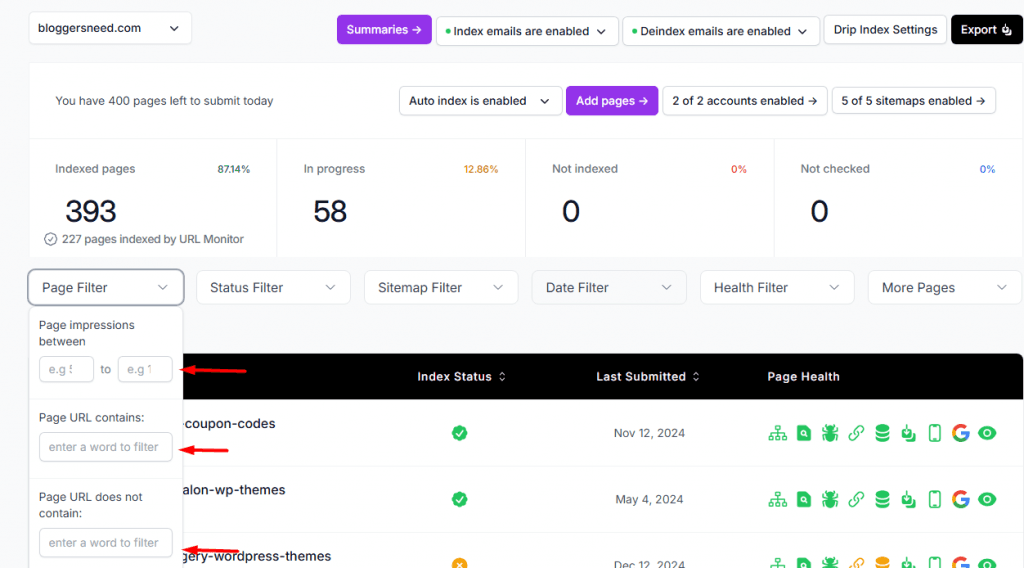
Status Filter
The URL Monitor app provides a comprehensive way to track the indexing status of your web pages. Below is a breakdown of the current statuses you can monitor.
- In Progress: Pages that are currently being processed for indexing. This status indicates that the URL Monitor is actively working on these pages.
- Indexed: Pages that have been successfully indexed by Google or Bing. These pages are now searchable and can be found in search results.
- Indexed by URL Monitor: Pages that have been confirmed as indexed specifically through the URL Monitor tool. This provides an additional layer of verification.
- Likely Indexed: Pages that are probably indexed based on the monitoring data, but not officially confirmed. This status suggests a high likelihood of visibility in search engines.
- Not Indexed: Pages that have not been indexed by Google or Bing. This could be due to various reasons, such as low-quality content or technical issues.
- Not Checked: Pages that have not yet been evaluated for indexing status. These URLs are pending review.
- Queued: Pages that are awaiting processing. This status indicates that the URLs are in line to be checked for indexing.
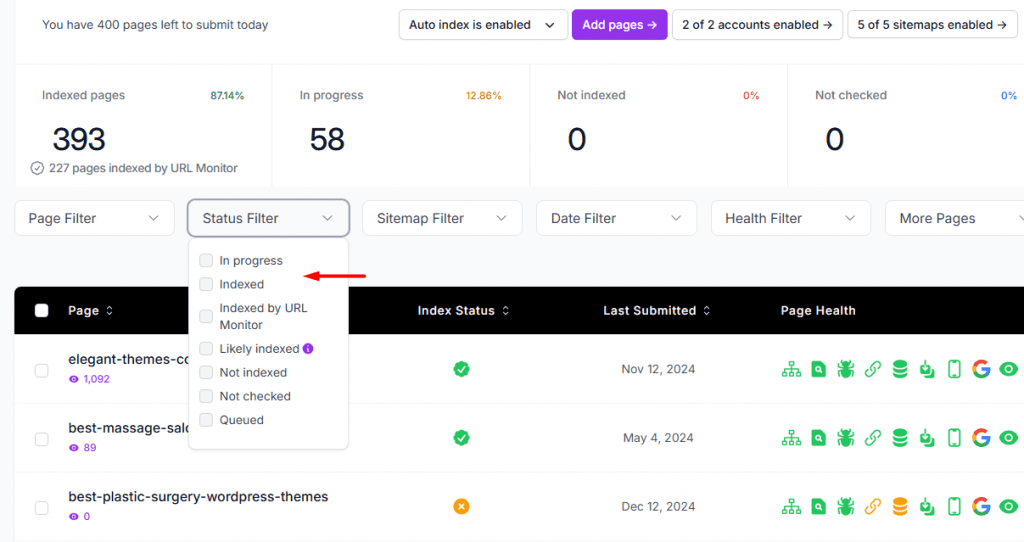
Sitemap Filter
XML sitemaps serve as valuable tools for managing expansive websites through automated URL filtering and importing.
Adding a sitemap to your website indeed helps crawlers and bots navigate your site’s structure effectively.
The URL Monitor includes a sitemap filter that displays pages based on your selection.
- In sitemap: Show the pages that are included in the sitemap.
- Manually added: Displays the pages that have been manually added to the sitemap.
- Sitemap is enabled: Displays the pages that are enabled in the sitemap.
- Sitemap is disabled: Displays pages where the sitemap is not enabled.
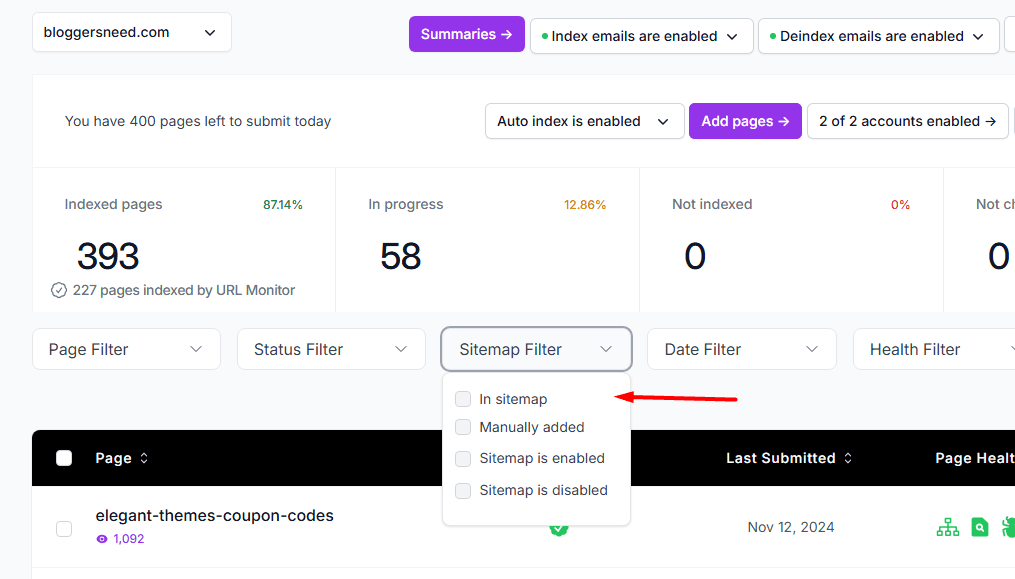
This approach offers several key advantages:
When scanning websites, the system automatically locates and retrieves XML sitemap data.
Custom patterns and parameters determine which URLs pass through the filtering process.
Specialized filter rules help eliminate unnecessary or redundant URLs.
The monitoring system dynamically adjusts as sitemap content evolves.
Date Filter
URL Monitor’s date filtering capabilities, allows precise tracking of online changes across various time intervals.
Using the date filter, you can enter a specific date to check both submitted URLs and indexed URLs from that day.
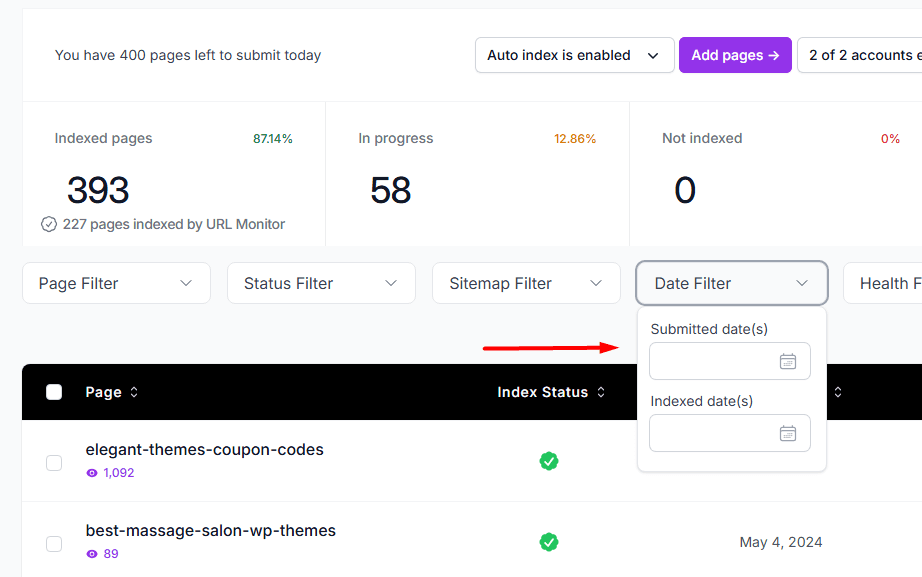
Health Filter
Another key feature of this URL Monitor review is its health filter, which goes beyond basic monitoring to deliver comprehensive insights about URL health.
Below is a list of technical issues visible in the health filter view.
- Canonical mismatch: Shows URLs with canonical tags pointing to unintended pages.
- Duplicate without canonical: Lists URLs without canonical tags, leading to duplicate content issues.
- Robots.txt blocked: Displays URLs blocked by the
robots.txtfile. - Noindex in meta tag: Shows URLs with a
noindexdirective in the meta tag. - Noindex in X-Robots-Tag: Lists URLs with a
noindexdirective in the X-Robots-Tag header. - Soft 404: Displays URLs returning a 200 status but showing “Page Not Found.”
- Page not found (404): Shows URLs that return a 404 error.
- Unauthorized request (401): Lists URLs requiring authentication to access.
- Server error (5xx): Displays URLs returning server-side 5xx errors.
- Redirect error: Shows URLs with improper redirects, including loops or chains.
- Access denied (403): Lists URLs that are restricted with a 403 status code.
- Internal error: Displays URLs affected by server configuration or execution errors.
- Invalid URL: Shows URLs with improper formatting or illegal characters.
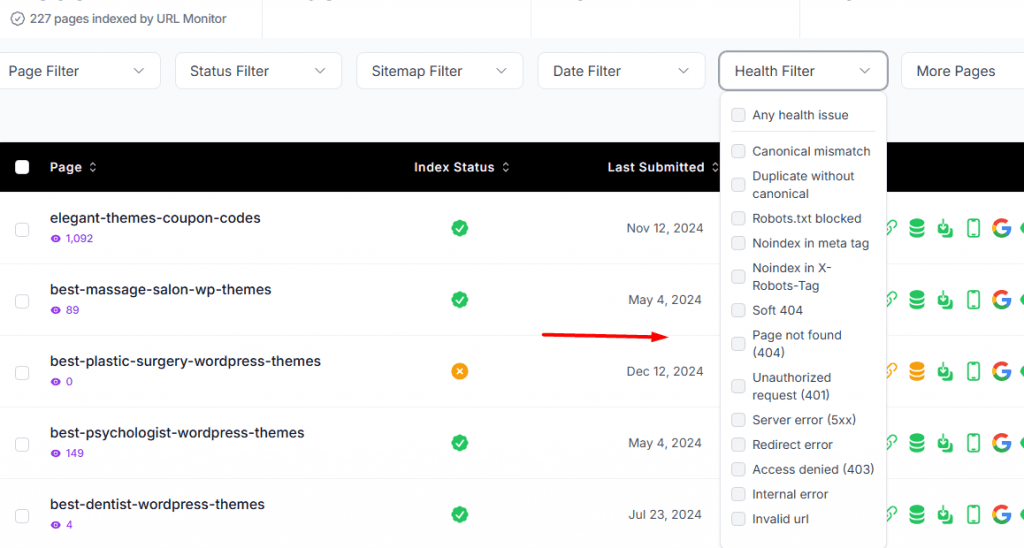
Weekly Custom Reports
In this URL Monitor review, I’ll walk you through the weekly custom reports feature that includes both index and deindex email alerts.
You’ll receive automated notifications when URLs become newly indexed in search results or when previously indexed URLs drop out of the index.
These customizable alerts help me track critical URL changes across my sites and take quick action when indexing issues arise.
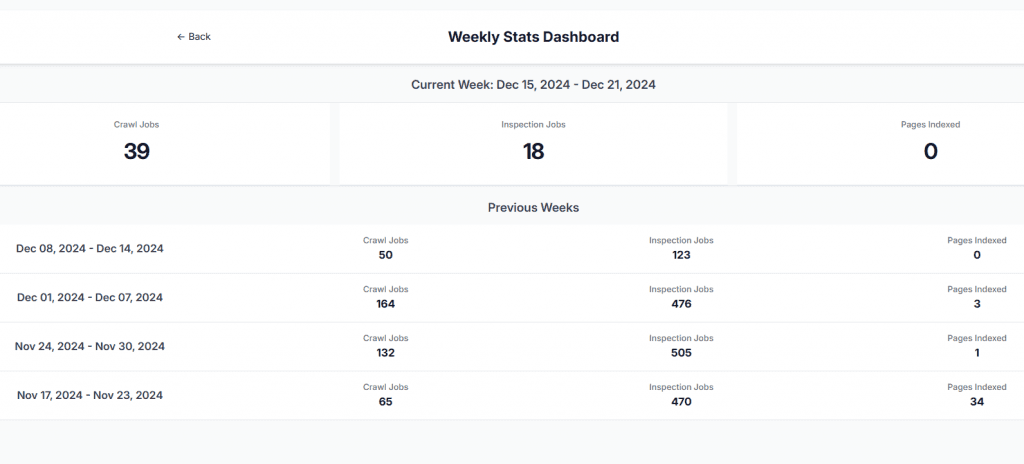
Index Email Alert
Track your website’s search engine visibility with URL Monitor’s Index Email Alert system.
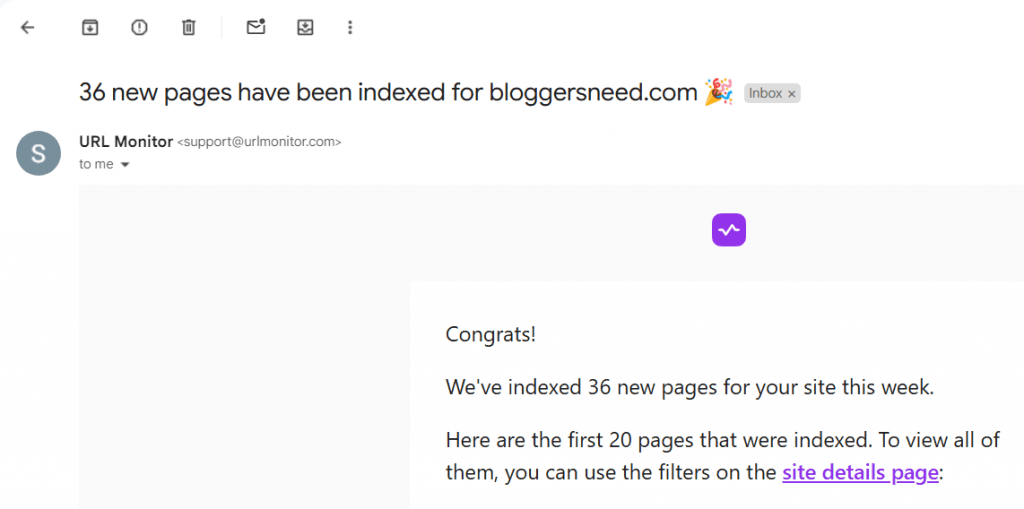
Weekly custom reports deliver comprehensive insights about your pages’ indexing status, sent automatically to your inbox. This intelligent monitoring spans major search engines, giving you a clear picture of your site’s digital footprint.
- Live monitoring across Google, Bing, and Yahoo
- Smart notifications based on your defined index thresholds
- Complete analysis of indexed and non-indexed content
- Long-term visibility trends and pattern recognition
Deindex Email Alert
When search engines remove your pages from their results, URL Monitor’s Deindex Email Alert system springs into action with instant notifications.
Through automated emails, I learn about possible causes behind the Google deindexing issues, whether they stem from technical glitches, manual penalties, or search algorithm changes.
Armed with this timely information, I can swiftly identify and fix problems before they severely affect my website’s search visibility and traffic levels.
Drip Auto Indexing
When managing multiple URLs, Drip Auto Indexing streamlines organization through systematic categorization and performance tracking. This automated feature transforms what was once a labor-intensive process into an efficient, intelligent system.
At regular intervals, the tool scans and indexes new URLs while organizing them into nested categories shaped by domain patterns and key metrics.
Real-time monitoring capabilities merge seamlessly with existing auto indexing frameworks, while detailed performance reports keep users informed of indexing progress.
By automating URL categorization, the system dramatically reduces manual effort without sacrificing accuracy. Even as URL lists expand into the hundreds or thousands, this intelligent approach maintains meticulous data organization and reliable tracking across diverse domains.
Features include:
- Dynamic URL detection and indexing on customizable schedules
- Smart categorization based on domain behavior and metrics
- Seamless integration with existing indexing infrastructure
- Comprehensive performance analytics and status tracking
Manual Indexing and Deindexing
Although URL Monitor’s auto drip feature helps index thousands of links, manual indexing and deindexing allows users to selectively control which pages to index or remove from search results.
I use this feature to manually add URLs that failed to index during the drip auto-feed process.
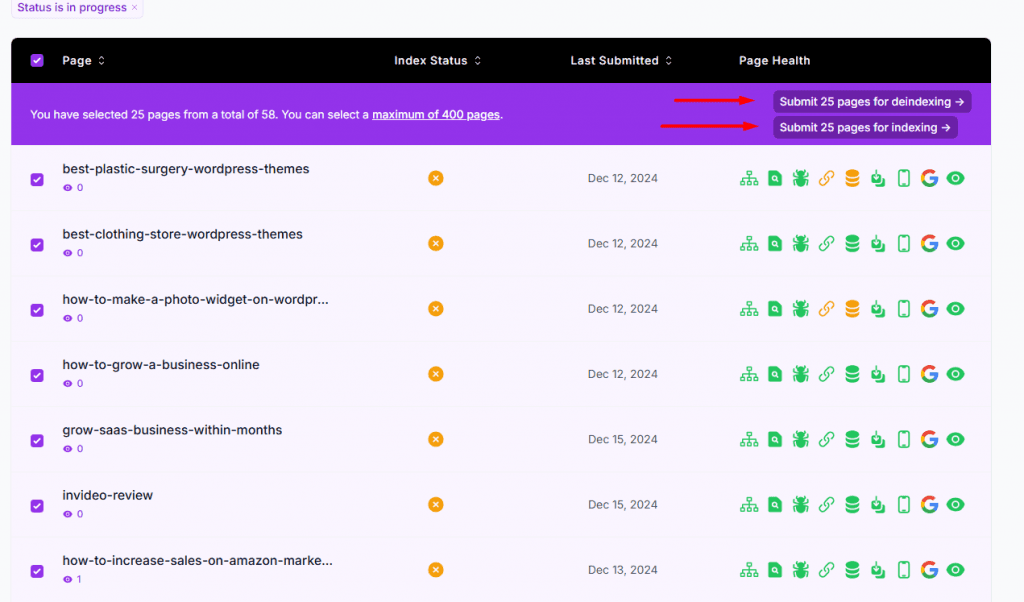
Who can use URL Monitor?
URL Monitor serves a diverse user base, from SEO professionals tracking search engine rankings to website owners monitoring performance metrics.
E-commerce owners can use URL Monitor to index large product inventories, and it also helps news websites that publish hundreds of articles daily.
While technical knowledge isn’t required, basic familiarity with website monitoring concepts helps users maximize the tool’s potential.
Thanks to an intuitive dashboard and comprehensive documentation, new users can quickly master essential functions without extensive training.
URL Monitor Review: My Final Verdict
Through a year of rigorous testing, URL Monitor has proven itself the best website indexer, combining robust monitoring capabilities with intuitive design and instant alerts.
The platform’s strength lies in its dependable website oversight – a characteristic I’ve witnessed firsthand across diverse browsers and devices.
Its performance metrics speak volumes:
- Delivering 97.9% indexing rate
- Dispatching critical alerts in under 30 seconds
- Supporting more than 15 notification channel options
- Offering a flexible dashboard with 25+ monitoring metrics
Whether deployed by individual webmasters or large-scale enterprises, URL Monitor excels in meeting diverse monitoring needs.
Pros and Cons of URL Monitor
A review is not complete without the pros and cons. I know you need it too.
Let me share you about it.
Pros of URL Monitor
- An understandable user interface; I connected my sites with just a few clicks.
- Affordable plans, I’m using their $10 plan, which allows me to submit 400 pages per day.
- It indexed some pages that were always avoided by Google
Cons of URL Monitor
- You can only index your site pages, not backlinks. However, you can check out this guide to learn how to index backlinks faster.
URL Monitor Review: FAQs
Can URL Monitor Index Multiple Websites Simultaneously?
Yes, URL Monitor can index multiple websites simultaneously, allowing users to manage and track the indexing status of various URLs from a single dashboard.
Does URL Monitor Offer Customer Support and Technical Assistance?
URL Monitor’s support team is readily accessible via both email and live chat channels. Technical assistance is available throughout regular business hours, with their team providing swift solutions for monitoring-related concerns.
What Payment Methods Are Accepted for URL Monitor Subscriptions?
URL Monitor offers flexible payment options, including major credit cards, PayPal, and bank transfers. When selecting your monitoring plan, you can choose from these secure payment methods to process your subscription.
Is There a Mobile App Version of URL Monitor Available?
Though URL Monitor doesn’t offer a dedicated mobile app, users can still access its core functionality through any mobile web browser.
Can URL Monitor Detect and Notify About Website Security Issues?
URL Monitor detects and notifies you of indexing issues only. For website security, use dedicated WordPress security tools or plugins.
Affiliate Disclosure: Some of the links in this post are affiliate links, which means I may earn a small commission if you make a purchase through those links. This comes at no extra cost to you. Thank you for your support!
URL Monitor Review
-
Indexing Accuracy
-
Indexing Speed
-
Pricing
-
User Experience
-
Support
Summary
This URL Monitor review comes from Abdullah Prem, who has used it for one year. In this review, you’ll learn how it solved our blog indexing issues, explore its features, and determine if this tool is right for you.
